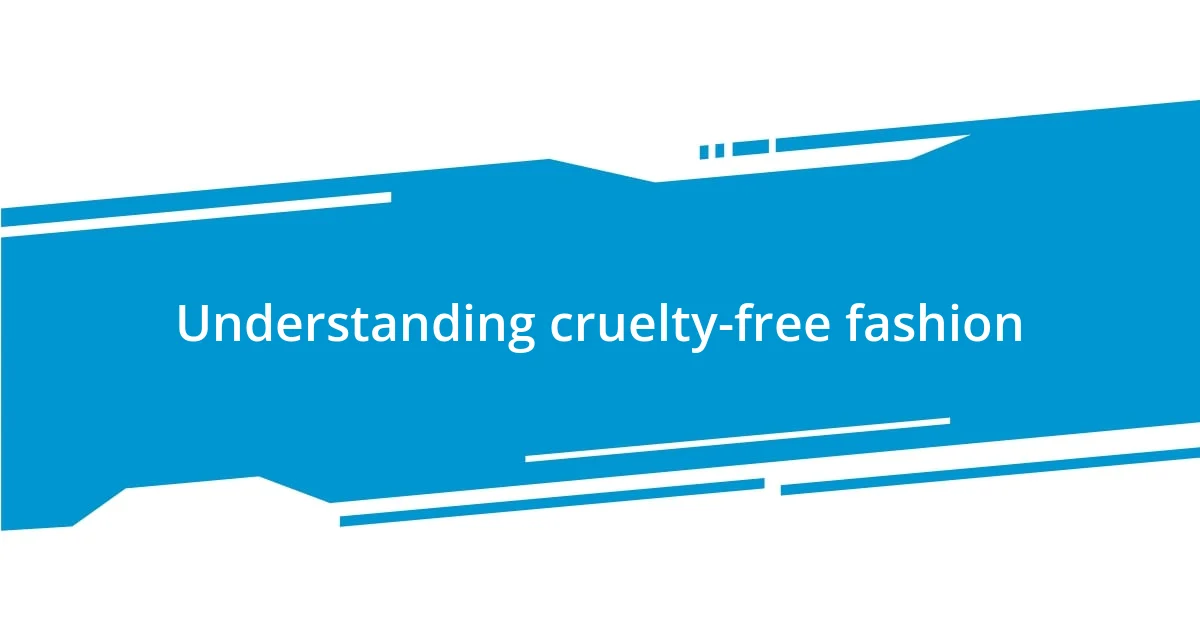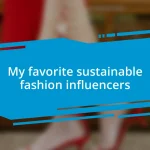Key takeaways:
- Cruelty-free fashion prioritizes animal welfare, sustainability, and ethical labor practices, empowering consumers to make conscientious choices.
- Identifying ethical brands involves looking for transparency, certification labels, sustainable materials, fair labor practices, and community engagement.
- Advocating for cruelty-free practices includes sharing knowledge with others and supporting brands that reflect ethical values for a collective positive impact in the fashion industry.

Understanding cruelty-free fashion
Cruelty-free fashion, at its core, prioritizes the well-being of animals throughout the production process. When I first learned about the unethical practices behind some mainstream clothing brands, it left me feeling disheartened. How could something as simple as a wool sweater contribute to animal suffering?
The beauty of cruelty-free fashion is that it embraces alternatives that don’t harm animals, such as organic cotton, hemp, and synthetic fibers. I remember the first time I wore a shirt made from bamboo – not only was it incredibly soft, but I felt an emotional connection to the choice I made. It’s amazing how a single decision can align with your values and create a sense of empowerment.
Understanding cruelty-free fashion also means being aware of the broader implications, including sustainability and ethical labor practices. I often find myself asking: when I support brands that are cruelty-free, am I also supporting a healthier planet? The answer, from my experience, is a resounding yes.

Reasons to choose cruelty-free
Choosing cruelty-free fashion is a step toward a more compassionate lifestyle. When I switched to cruelty-free brands, I felt a weight lift off my conscience. It was like shedding a layer of guilt that had been hiding just beneath the fabric of my choices. Knowing that my wardrobe respects animal welfare is incredibly rewarding.
The health of our planet is another crucial reason to embrace cruelty-free options. Every piece I buy not only reflects my values but also supports sustainable practices. It’s incredible to think that what I wear can affect the environment. For example, when I opted for a vegan leather jacket, I felt proud not just for my ethical choice but also for contributing to less waste and a healthier ecosystem.
Moreover, there’s a growing community around cruelty-free fashion that fosters connection and awareness. I’ve attended events where like-minded individuals passionately share stories about their ethical fashion journeys. It’s uplifting to realize that I’m part of a movement that encourages compassion and responsibility in the fashion industry. It reminds me that every purchase is more than just a transaction; it’s a vote for a better world.
| Point | Cruelty-Free Fashion |
|---|---|
| Animal Welfare | Protects animals from harm and exploitation |
| Sustainability | Encourages environmentally friendly materials and practices |
| Community | Connects individuals passionate about ethical choices |

Identifying ethical brands
Identifying ethical brands can be a bit of a puzzle, but I’ve found that paying attention to a few key factors really helps. First off, I look for transparency. Brands that openly share their sourcing practices and labor conditions demonstrate a commitment to ethical standards. When I stumbled upon a small company that detailed their entire supply chain on their website, I felt a sense of trust and authenticity that’s often missing in bigger labels.
Here are some helpful indicators for identifying ethical brands:
- Certification Labels: Look for labels like GOTS (Global Organic Textile Standard) or PETA-approved vegan to ensure the brand meets specific ethical criteria.
- Material Choices: Brands that prioritize organic, recycled, or sustainable materials tend to have a more responsible approach.
- Fair Labor Practices: Seek brands that are transparent about their labor policies and ensure fair wages for workers.
- Community Engagement: Ethical brands often give back to their communities, so check if they support local causes or charities.
- Customer Reviews: Take a peek at reviews that mention the brand’s values; real experiences can provide insight into their practices.
By aligning my choices with these criteria, I feel more connected to the brands I support. Each purchase becomes a reflection of my values and a way to advocate for a kinder fashion industry.

Building a cruelty-free wardrobe
Building a cruelty-free wardrobe is an evolving journey that requires a bit of mindfulness and creativity. When I first began curating my closet, I found myself delighting in the small details—like discovering a pair of shoes made from recycled materials. It felt like I was unearthing hidden treasures that not only complemented my style but also aligned with my ethics. Have you ever felt that rush of excitement when you find something that resonates with your values?
Shopping second-hand has also become one of my favorite strategies for building a cruelty-free wardrobe. Each thrift store visit is like an adventure; I get to sift through unique pieces that have their own stories. I remember scoring a vintage leather bag that, despite being used, had so much character and zero new animal cruelty involved. It’s amazing how a little creativity can breathe new life into sustainable fashion choices!
As I grew more conscious of my clothing selections, I began to understand the importance of versatile items. By investing in wardrobe staples—like a classic dress or a well-fitted pair of jeans—I can mix and match in countless ways while maintaining my cruelty-free philosophy. It’s a powerful reminder that making thoughtful choices can lead to enhanced creativity and a well-rounded personal style. Have you considered how simplifying your wardrobe might lead to greater expression in what you wear?

Sustainable materials to consider
Sustainable materials play a crucial role in shaping a cruelty-free wardrobe. For instance, I recently discovered Tencel, a fabric made from responsibly sourced wood pulp. The first time I wore a Tencel dress, I was amazed at how soft it felt—almost like wearing a gentle hug. It’s the perfect example of how sustainable choices can be luxurious and kind to the planet.
Another material worth considering is organic cotton. Unlike conventional cotton, which often involves harmful pesticides, organic cotton is grown without these chemicals. I remember buying an organic cotton t-shirt that not only looked great but also felt good to wear, knowing that it was produced with care for both the environment and the people involved in its creation. Have you ever thought about how the fabric you choose can impact the climate?
Recycled materials are also a game-changer in sustainable fashion. For instance, I found a stunning pair of leggings made from recycled plastic bottles. It was a little surreal to think that something so stylish had once been trash. This experience reminds me that the journey towards cruelty-free fashion isn’t just about avoiding products that are harmful; it’s also about embracing those that offer a second life to waste and contribute to the sustainability of our planet.

Tips for ethical shopping
When embarking on ethical shopping, I’ve learned to prioritize transparency from brands. I often find myself checking a company’s commitment to ethical practices and labor conditions before making a purchase. You know, it feels reassuring when a brand openly shares its sourcing methods and treatment of workers. Have you ever felt more confident in your purchase when you knew the story behind it?
Another tip I embrace is to create a wishlist rather than impulse shopping. I recall a time when I was tempted by a trendy item but decided to wait a week. That waiting period helped me realize it wasn’t a true reflection of my style or values. I ended up investing in pieces that I genuinely loved and would wear repeatedly. Planning your purchases can help ensure each item in your wardrobe aligns with your ethical standards—how empowering is that?
Lastly, don’t shy away from engaging with brands and asking questions. I remember sending an email to a local designer, inquiring about the materials used in a jacket I admired. Not only did they respond promptly, but they also shared their passion for sustainable practices, which made me feel a deeper connection to their work. Engaging with brands reinforces the importance of ethical choices and helps foster a community centered around compassion in fashion. Have you tried reaching out to your favorite brands? You might be pleasantly surprised by the conversations you spark!

Advocating for cruelty-free practices
Advocating for cruelty-free practices goes beyond selecting the right fabrics; it’s about fostering a mindset that demands ethical treatment of animals across the fashion industry. I remember the moment I learned about the impacts of fur and leather production on animals. It was heart-wrenching to realize that behind the luxury of some fashion items lay suffering and exploitation. That understanding shifted my perspective and fueled my passion to advocate for alternatives that prioritize compassion.
One of the most empowering aspects of this advocacy is sharing knowledge with others. I often host small gatherings where we discuss the importance of cruelty-free fashion. At one of these events, a friend shared how she reconsidered her shopping habits after learning about cruel practices in the industry. Watching her transform into an advocate herself was incredibly inspiring; it reminded me that raising awareness can have a ripple effect. Have you ever thought about the conversations you could start with friends or family?
Moreover, I take every opportunity to support brands that align with cruelty-free values. Recently, I stumbled upon a boutique that exclusively features vegan leather handbags, and the craftsmanship was stunning. It felt rewarding to invest in pieces that reflected my values, knowing I was supporting a brand committed to ethical practices. In this journey, I’ve learned that our choices can create a collective impact, encouraging the industry to evolve toward more compassionate solutions. How fulfilling is it to be part of a movement dedicated to lasting change?















